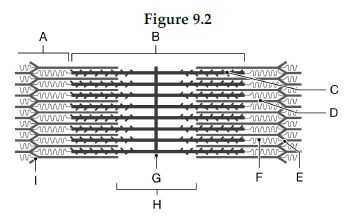Using the figure below, identify the labeled part.

1) Label A: ______________________________
2) Label B: ______________________________
3) Label C: ______________________________
4) Label D: ______________________________
5) Label E: ______________________________
6) Label F: ______________________________
7) Label G: ______________________________
8) Label H: ______________________________
9) Label I: ______________________________
1) I band
2) A band
3) Thick filaments
4) Thin filaments
5) Z line
6) Titin
7) M line
8) H band
9) Z line
You might also like to view...
Metabolic syndrome is an early indicator that someone may be at risk for ________ .
a. insulin shock b. hypoglycemia c. diabetes d. low blood sugar e. metabolic acidosis
G cells of the stomach secrete
A) pepsin. B) secretin. C) enterokinase. D) gastrin. E) cholecystokinin.
How is it possible to remove a section of lung without damaging neighboring sections?
A. The bronchopulmonary segments are separated from each other by connective tissue septa. B. Surgeons cauterize any freshly cut portion of the lung to seal it. C. Lungs are actually comprised of multiple separate structures each served by its own bronchus. D. It isn't possible to perform this type of surgery on the lungs.
DNA mutation and development of cancerous cells are less dangerous in epithelial tissue than in connective tissue because epithelia
A) have desmosomes. B) have tight junctions. C) have gap junction. D) have apical surface. E) are avascular.